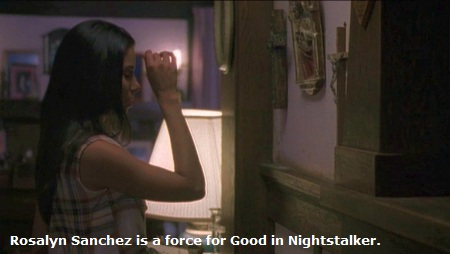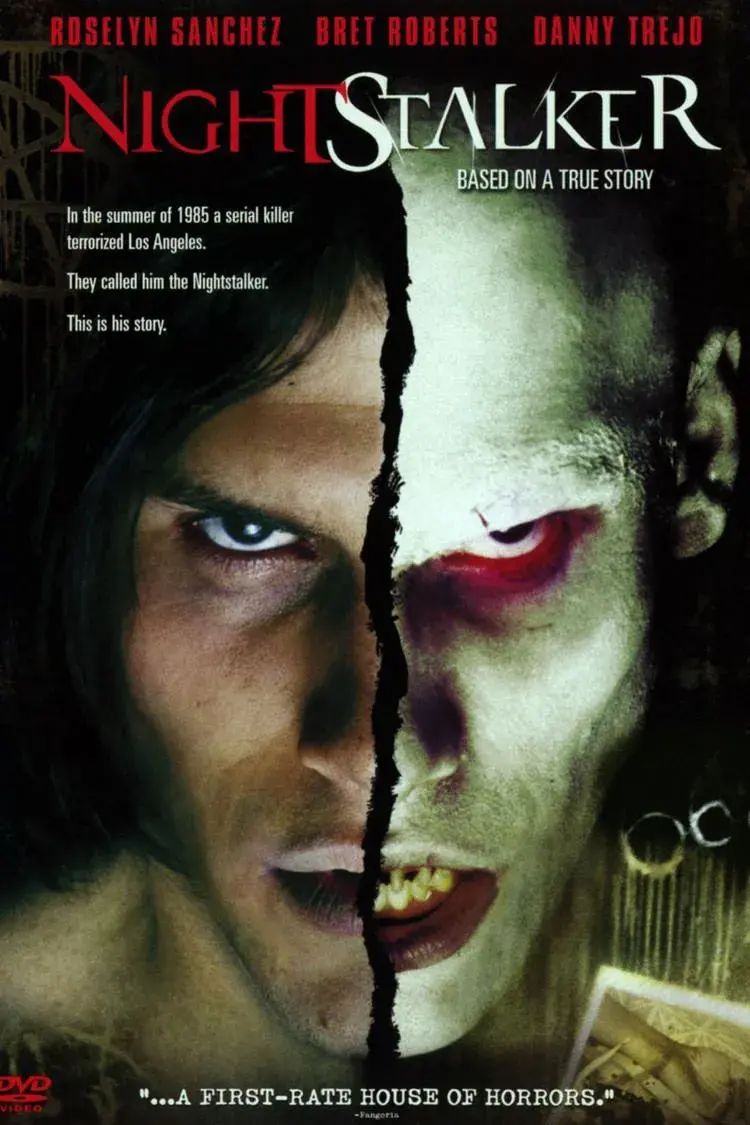|
Nightstalker Film review by Thomas M. Sipos |
|
MENU Books Horror Film Festivals and Awards
Pursuits
Blogs Horror Film Festivals and Awards
Other
|
NightStalker (2002, dir: Chris Fisher; cast: Rosalyn Sanchez, Bret Roberts, Joseph McKelheer)
Documentaries
aside, four films have so far been made about Ramirez.
Nightstalker (2002) is the second.
Writer/director Chris Fisher makes heavy use of such jump cuts. He
also borrows a technique first used in the supernatural horror film,
Jacob's Ladder: the rapidly shaking head, which has become
a cinematic cliché for evil and/or possession (e.g.,
Lost Souls). Fisher's Satan often
rapidly shakes his head. As do a surprisingly large number of
"normal" people throughout the film. Why is Satan flickering about Ramirez? The real Ramirez was a Satanist and drug user. The one in the film believes Satan is ordering him to kill. ("I did it for you!" he exclaims.) Like his master, Ramirez also flashes and flickers about the rooms as he kills his victims. Are we seeing murders through the eyes of an insane drug addict? Or is Satan real?
Fisher's cinematic tricks don't work for a "true crime" film. But they go far in establishing the right mood for Nightstalker. Los Angeles in 1985 is saturated by Evil. Ramirez's nemesis is LAPD Detective Gabriella Martinez (Rosalyn Sanchez). She's a devout Catholic who cares for her ailing mother in East L.A. She prays fervently every night before a crucifix, the camera hovering in extreme closeups about her quivering lips and tightly clutched rosary.
 She is a fortress of Faith surrounded by encroaching evil. Her black
police lieutenant boss (Evan Parker) sexually harasses her. When he
does so, his head, briefly, shakes rapidly. He too is possessed by
Evil. Sanchez's Latino partner (Danny Trejo) snorts cocaine in the
squad car, his head shaking rapidly. Martinez's white partner (Derek
Hamilton) turns vigilante, his head shaking rapidly. The Evil lurks
in women too. A gal reporter (Brandi Emma) convinces Martinez to give
her a confidential police sketch of Ramirez, then breaks her word and
exposes Martinez as her source. Martinez hoped that the newspaper
publishing the sketch would save lives. But the reporter didn't care
about saving lives, only making a name for herself. Exposing Martinez
as the source saved no one, but made the story juicier.
Martinez has
other troubles. Her elderly mother is senile, a burden on Martinez,
who's turned down better job offers to stay in East L.A. and care
for her mom. The mother claims that Satan visited her. Was it Ramirez,
or Satan, or her dementia? These problems are additional crosses
for Martinez to bear, emphasizing Satan's assaults upon her faith
and character. Review copyright by Thomas M. Sipos
|
"Communist Vampires" and "CommunistVampires.com" trademarks are currently unregistered, but pending registration upon need for protection against improper use. The idea of marketing these terms as a commodity is a protected idea under the Lanham Act. 15 U.S.C. s 1114(1) (1994) (defining a trademark infringement claim when the plaintiff has a registered mark); 15 U.S.C. s 1125(a) (1994) (defining an action for unfair competition in the context of trademark infringement when the plaintiff holds an unregistered mark).


 Serial
killer Richard Ramirez (aka "the Night Stalker") terrorized the Los
Angeles area from 1984 until his arrest a year later. He was
sentenced to death in 1989, and died of natural causes in 2013 while
on Death Row.
Serial
killer Richard Ramirez (aka "the Night Stalker") terrorized the Los
Angeles area from 1984 until his arrest a year later. He was
sentenced to death in 1989, and died of natural causes in 2013 while
on Death Row.
